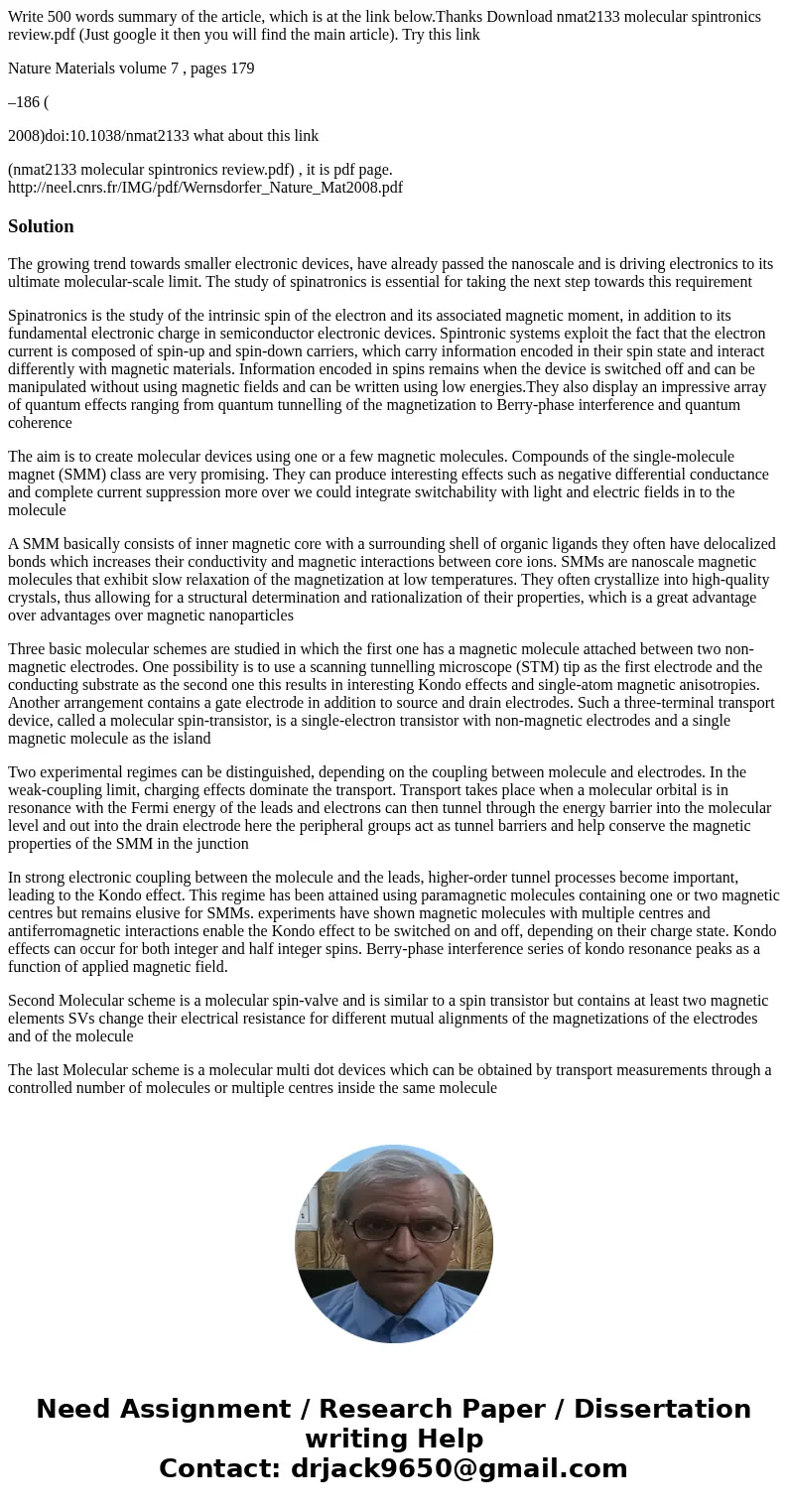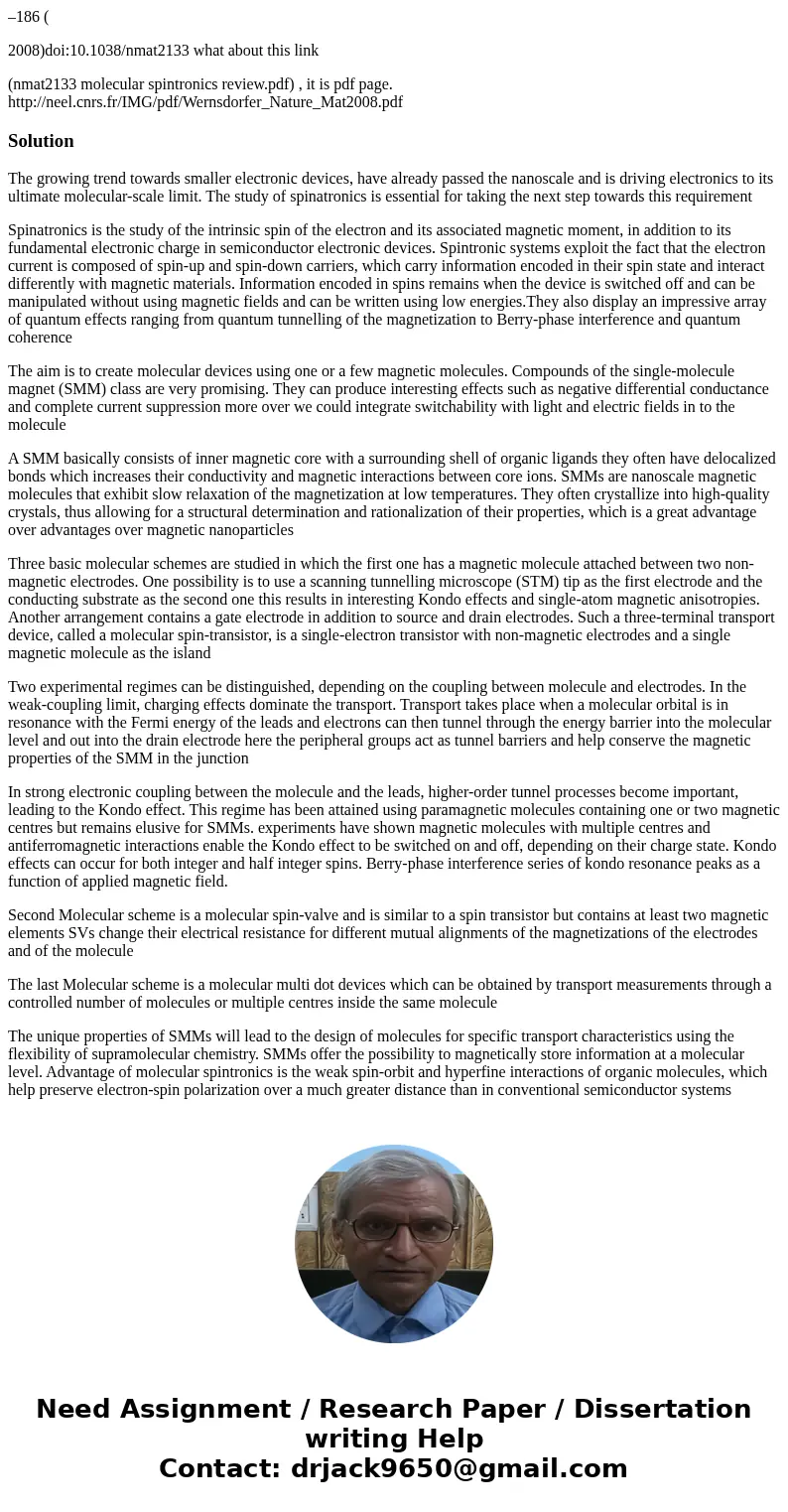Write 500 words summary of the article which is at the link
Write 500 words summary of the article, which is at the link below.Thanks Download nmat2133 molecular spintronics review.pdf (Just google it then you will find the main article). Try this link
Nature Materials volume 7 , pages 179
–186 (
2008)doi:10.1038/nmat2133 what about this link
(nmat2133 molecular spintronics review.pdf) , it is pdf page. http://neel.cnrs.fr/IMG/pdf/Wernsdorfer_Nature_Mat2008.pdf
Solution
The growing trend towards smaller electronic devices, have already passed the nanoscale and is driving electronics to its ultimate molecular-scale limit. The study of spinatronics is essential for taking the next step towards this requirement
Spinatronics is the study of the intrinsic spin of the electron and its associated magnetic moment, in addition to its fundamental electronic charge in semiconductor electronic devices. Spintronic systems exploit the fact that the electron current is composed of spin-up and spin-down carriers, which carry information encoded in their spin state and interact differently with magnetic materials. Information encoded in spins remains when the device is switched off and can be manipulated without using magnetic fields and can be written using low energies.They also display an impressive array of quantum effects ranging from quantum tunnelling of the magnetization to Berry-phase interference and quantum coherence
The aim is to create molecular devices using one or a few magnetic molecules. Compounds of the single-molecule magnet (SMM) class are very promising. They can produce interesting effects such as negative differential conductance and complete current suppression more over we could integrate switchability with light and electric fields in to the molecule
A SMM basically consists of inner magnetic core with a surrounding shell of organic ligands they often have delocalized bonds which increases their conductivity and magnetic interactions between core ions. SMMs are nanoscale magnetic molecules that exhibit slow relaxation of the magnetization at low temperatures. They often crystallize into high-quality crystals, thus allowing for a structural determination and rationalization of their properties, which is a great advantage over advantages over magnetic nanoparticles
Three basic molecular schemes are studied in which the first one has a magnetic molecule attached between two non-magnetic electrodes. One possibility is to use a scanning tunnelling microscope (STM) tip as the first electrode and the conducting substrate as the second one this results in interesting Kondo effects and single-atom magnetic anisotropies. Another arrangement contains a gate electrode in addition to source and drain electrodes. Such a three-terminal transport device, called a molecular spin-transistor, is a single-electron transistor with non-magnetic electrodes and a single magnetic molecule as the island
Two experimental regimes can be distinguished, depending on the coupling between molecule and electrodes. In the weak-coupling limit, charging effects dominate the transport. Transport takes place when a molecular orbital is in resonance with the Fermi energy of the leads and electrons can then tunnel through the energy barrier into the molecular level and out into the drain electrode here the peripheral groups act as tunnel barriers and help conserve the magnetic properties of the SMM in the junction
In strong electronic coupling between the molecule and the leads, higher-order tunnel processes become important, leading to the Kondo effect. This regime has been attained using paramagnetic molecules containing one or two magnetic centres but remains elusive for SMMs. experiments have shown magnetic molecules with multiple centres and antiferromagnetic interactions enable the Kondo effect to be switched on and off, depending on their charge state. Kondo effects can occur for both integer and half integer spins. Berry-phase interference series of kondo resonance peaks as a function of applied magnetic field.
Second Molecular scheme is a molecular spin-valve and is similar to a spin transistor but contains at least two magnetic elements SVs change their electrical resistance for different mutual alignments of the magnetizations of the electrodes and of the molecule
The last Molecular scheme is a molecular multi dot devices which can be obtained by transport measurements through a controlled number of molecules or multiple centres inside the same molecule
The unique properties of SMMs will lead to the design of molecules for specific transport characteristics using the flexibility of supramolecular chemistry. SMMs offer the possibility to magnetically store information at a molecular level. Advantage of molecular spintronics is the weak spin-orbit and hyperfine interactions of organic molecules, which help preserve electron-spin polarization over a much greater distance than in conventional semiconductor systems


 Homework Sourse
Homework Sourse